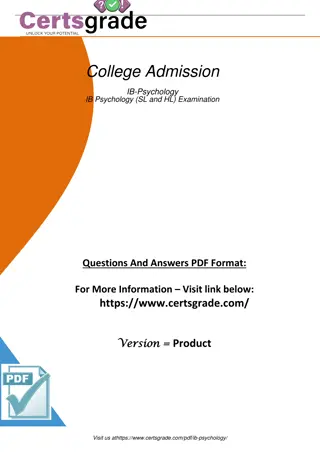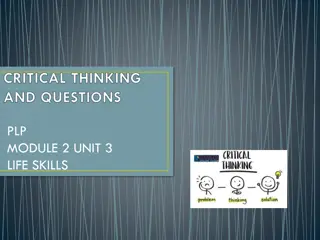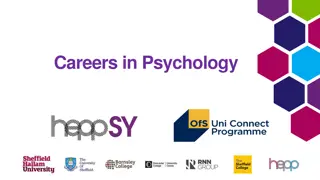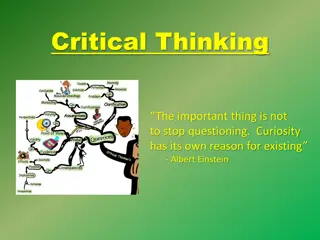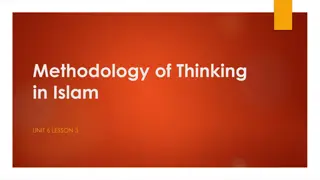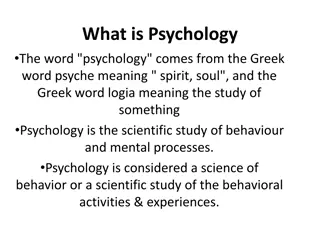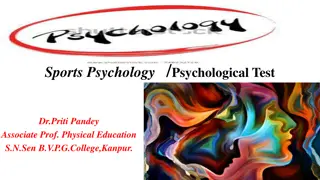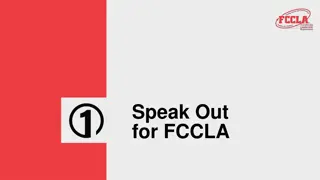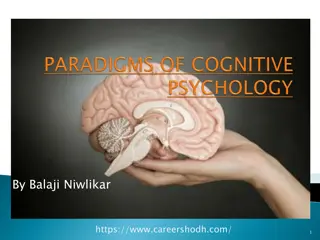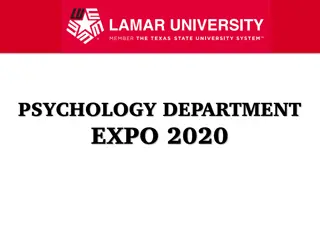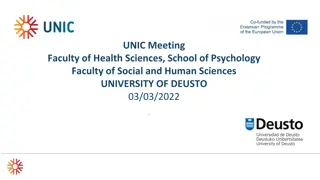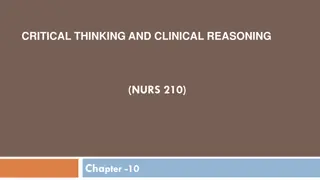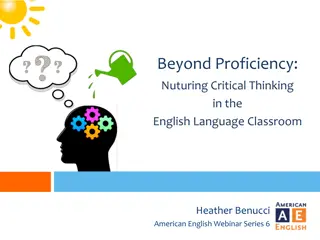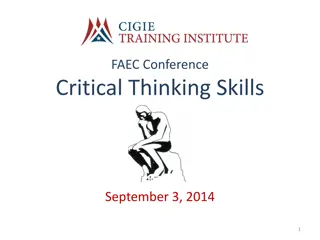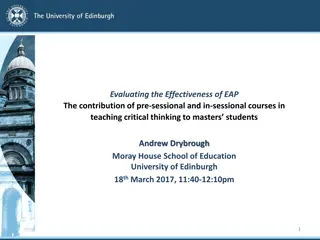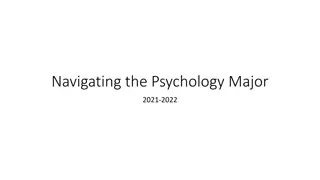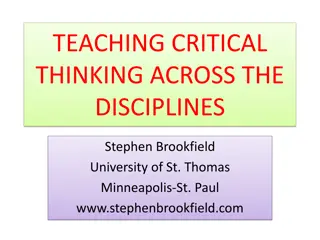Unleashing Critical Thinking in Online Psychology Education
Explore the significance of critical thinking in psychology education, delving into theoretical frameworks and strategies for implementation in online classrooms. Discover why fostering a questioning attitude is essential for undergraduates to navigate a world filled with biases and misconceptions. Gain insights from Dr. Deborah Miller and Dr. Beth Trammel on unlocking students' potential to reason effectively and cultivate a fairminded approach to learning.
Download Presentation

Please find below an Image/Link to download the presentation.
The content on the website is provided AS IS for your information and personal use only. It may not be sold, licensed, or shared on other websites without obtaining consent from the author. Download presentation by click this link. If you encounter any issues during the download, it is possible that the publisher has removed the file from their server.
E N D
Presentation Transcript
TEACHING CRITICAL THINKING IN ONLINE CLASSROOMS Strategies for success and considerations for the future Dr. Deborah Miller and Dr. Beth Trammell
OUR GOAL FOR TODAY As online education continues to grow, we want to push students in psychology to develop a questioning attitude that is continually open to new, scientifically based ideas. Today we will share: Why critical thinking is important for undergraduates. Theoretical underpinnings of critical thinking and its importance. Strategies to implement them in the online classroom. Data from our courses as evidence and what we have learned from it. Ways to implement these in your courses next semester. WOODGROVE 2 All images from free photo stock website pexels.com BANK
Why critical thinking is so important SO WHAT?? WOODGROVE 3 BANK
WHY IS CRITICAL THINKING SO IMPORTANT? Wouldn t we all love for our students to become critical thinkers of this sort: "Critical thinking is self-guided, self-disciplined thinking which attempts to reason at the highest level of quality in a fairminded way. They realize that no matter how skilled they are as thinkers, they...will at times fall prey to mistakes in reasoning, human irrationality, prejudices, biases, distortions, uncritically accepted social rules and taboos, self-interest, and vested interest. They embody the Socratic principle: The unexamined life is not worth living, because they realize that many unexamined lives together result in an uncritical, unjust, dangerous world. ~ Linda Elder, September, 2007 Student misconceptions [in psychology] are often deeply embedded beliefs, and are strongly supported by personal evidence making them difficult to change (Hughes, Lyddy & Lambe, 2013). WOODGROVE 4 BANK
THEORETICAL FRAMEWORKS Paul-Elder critical thinking framework & the Community of Inquiry Model WOODGROVE 5 BANK
PAUL-ELDER CRITICAL THINKING FRAMEWORK The elements or structures of thought enable us to "take our thinking apart" and analyze it. The intellectual standards are used to assess and evaluate the elements. The intellectual traits are dispositions of mind embodied by the fairminded critical thinker. To cultivate critical thinking, we need command of these essential dimensions WOODGROVE 6 BANK
WOODGROVE 7 BANK
COMMUNITY OF INQUIRY (COI) MODEL Critical thinking is best supported by a community- oriented classroom shaped by the presence of the instructor. Three elements interact to create a healthy community of inquiry (CoI) Teaching presence Social presence Cognitive presence WOODGROVE 8 BANK
Critical thinking exercises STRATEGIES WOODGROVE 9 BANK
STEPS TOWARD CRITICAL THINKING ONLINE Four steps for the online classroom Step 1 Course Design and Course planning Strong instructor presence Decrease anxiety and frustration Step 2 Examine their current belief system Quiz or survey Test of Common Beliefs (Vaughan (1977) McCutcheon Test of Misconceptions (1991) Step 3 Explicitly teach and promote critical thinking Encourage meaningful interactions Move beyond simple reflections Instructor feedback is key Step 4 Use refutational teaching and student-oriented examples WOODGROVE 10 BANK
CRITICAL THINKING EXERCISES Refutational Teaching Research on the instruction of critical thinking has demonstrated some promise in effectively reducing student misconceptions and their effect on learning psychology (Bensley, Lilienfeld, & Powell, 2014). (812) 855-7650 It has also been shown that students who score well on critical thinking tests have fewer misconceptions and show a greater reduction of misconceptions as a result of instruction (Kowalski and Taylor, 2004). Steps for refutational teaching Ripe for study in the online classroom WOODGROVE 11 BANK
SAMPLE ACTIVITY: INTRODUCING CRITICAL THINKING How many glasses of water should we drink each day? Many health sources recommend 8 glasses of water per day. Most people believe this is true. Why? Students are urged to think critically about this belief using 7 steps: What am I being asked to believe or accept? What evidence is available to support the claim? (What made you think this is true?) What alternative ways are there to interpret the evidence? How credible/valid are the evidence sources on a scale of 1-10? What assumptions or biases come up when thinking about this? What additional evidence would help us evaluate alternatives? What conclusions are most reasonable/likely? Finally, present students with an article explaining recent scientific consensus that humans do not need 8 glasses of water per day. Students report this is a very effective exercise My whole life feels like a lie now WOODGROVE 12 BANK
CRITICAL THINKING EXERCISES Problem-solving analysis protocol (P-SAP) (Steinke & Fitch, 2003) Takes a real-world issue and asks students four simple questions about that issue. In what way(s) might this be a problem? What are some possible causes of this problem? What could be done to try to solve this problem? What are the strengths and limitations of these possible solutions to the problem? Then set of scoring rubrics can be used for scoring and feedback. Also great tool for assessment. WOODGROVE 13 BANK
CRITICAL THINKING EXERCISES Debates about hot topics Again, real-world issues will help the students feel more connected. Have them argue against their current view Take a survey ahead of time Examples of hot topics we have used This can be in the discussion board or Voicethread WOODGROVE 14 BANK
CRITICAL THINKING EXERCISES: DISCUSSION BOARD AND REFLECTIONS Two common online assignment- types that students often do poorly. Great post! I totally agree! Adding an explicit critical thinking component to discussion and reflection assignments can improve student performance while improving their CT skills. WOODGROVE 15 BANK
DISCUSSION BOARDS K-W-L discussion board or reflection assignment at beginning and end of online module What do you already Know? (draw out misconceptions) What do you Want to know? (develop curiosity) What did you Learn? (reflect) Apply Paul-Elder Intellectual Standards and Elements of Thought to controversial issues in your field. Initial post, a variety of peer responses, and a final reflection Students are given specific instruction on how to construct excellent discussion board posts and apply critical thinking skills Dr. Kamil Hamaoui of SUNY presents an excellent, detailed explanation of this type of discussion board assignment here: https://www.slideshare.net/alexandrapickett/05142014-fellow-chat- criticalthinking?ref=http://cotecommunity.open.suny.edu/group/criti cal-thinking WOODGROVE 16 BANK
CRITICAL THINKING EXERCISES What kind of person does Discussion board to get students interested in personality types early on. But also begins to show them about their own perceptions and biases Examples WOODGROVE 17 BANK
SUMMARY Let s step in! Teaching explicitly is important, though not necessarily in our job descriptions When engaged in thought-provoking, relatable topics, students enjoy and engage WOODGROVE 18 BANK
THANK YOU Dr. Deborah Miller +765 973 8266 milldebo@iue.edu Dr. Beth Trammell +765 973 8362 batramme@iue.edu
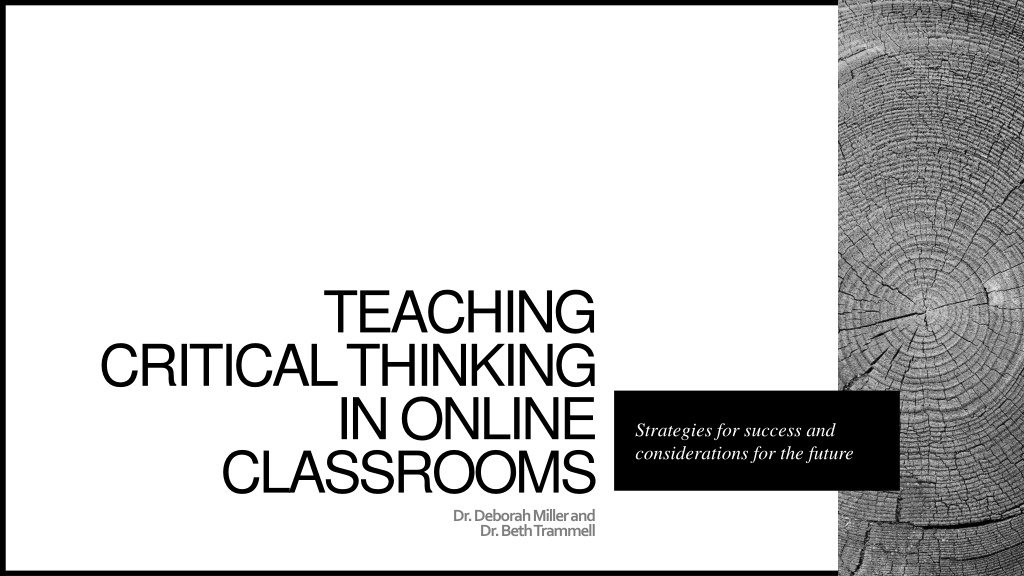
 undefined
undefined
























